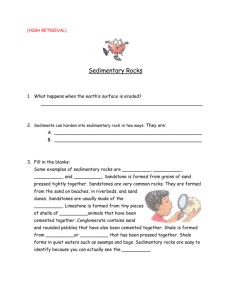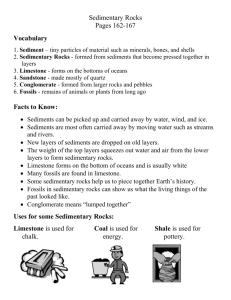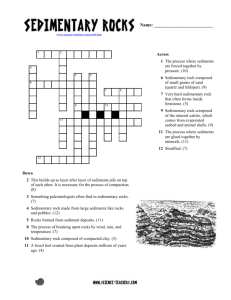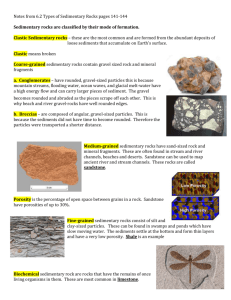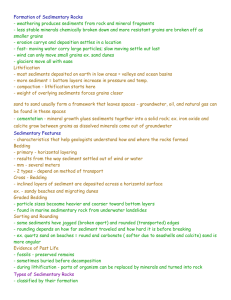Sedimentary rocks - FSU GK
advertisement
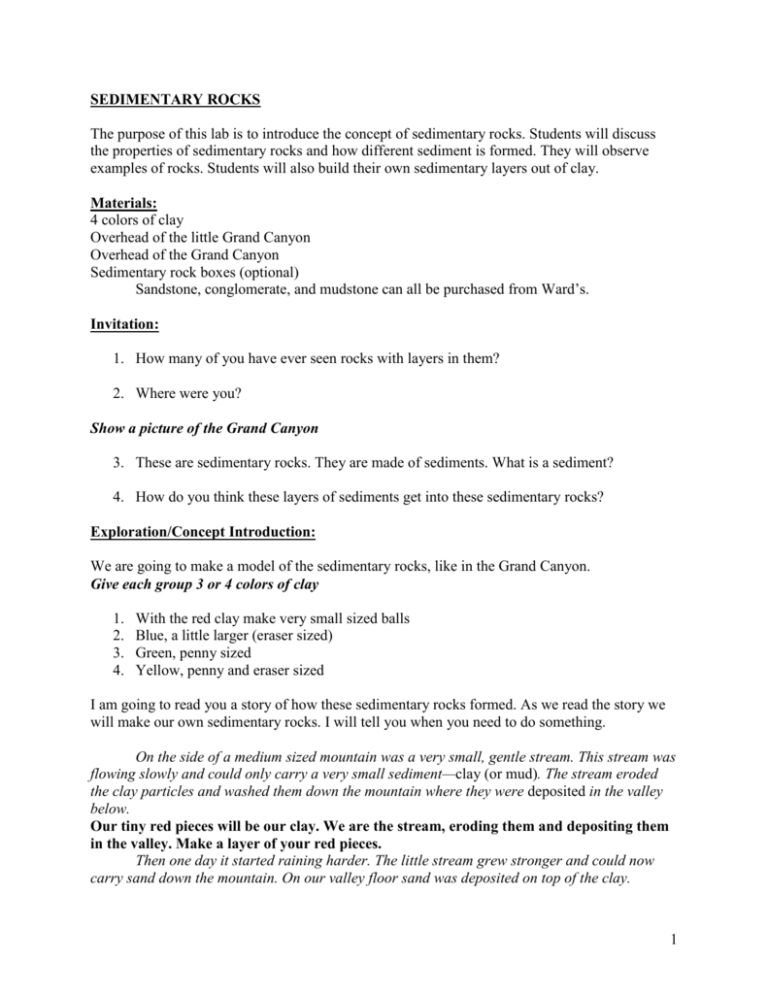
SEDIMENTARY ROCKS The purpose of this lab is to introduce the concept of sedimentary rocks. Students will discuss the properties of sedimentary rocks and how different sediment is formed. They will observe examples of rocks. Students will also build their own sedimentary layers out of clay. Materials: 4 colors of clay Overhead of the little Grand Canyon Overhead of the Grand Canyon Sedimentary rock boxes (optional) Sandstone, conglomerate, and mudstone can all be purchased from Ward’s. Invitation: 1. How many of you have ever seen rocks with layers in them? 2. Where were you? Show a picture of the Grand Canyon 3. These are sedimentary rocks. They are made of sediments. What is a sediment? 4. How do you think these layers of sediments get into these sedimentary rocks? Exploration/Concept Introduction: We are going to make a model of the sedimentary rocks, like in the Grand Canyon. Give each group 3 or 4 colors of clay 1. 2. 3. 4. With the red clay make very small sized balls Blue, a little larger (eraser sized) Green, penny sized Yellow, penny and eraser sized I am going to read you a story of how these sedimentary rocks formed. As we read the story we will make our own sedimentary rocks. I will tell you when you need to do something. On the side of a medium sized mountain was a very small, gentle stream. This stream was flowing slowly and could only carry a very small sediment—clay (or mud). The stream eroded the clay particles and washed them down the mountain where they were deposited in the valley below. Our tiny red pieces will be our clay. We are the stream, eroding them and depositing them in the valley. Make a layer of your red pieces. Then one day it started raining harder. The little stream grew stronger and could now carry sand down the mountain. On our valley floor sand was deposited on top of the clay. 1 The blue pieces will be sand grains. Make a layer of sand on top of your layer of clay. The sand layer was heavy on the clay and pressed down hard. The clay particles were packed together tightly—compacted. Press down on your layers like the sand would be pressing on the clay. The clay sediments began to cement together to form a sedimentary rock- mudstone. Much time passed. Now there were even larger storms and the trickling stream started to roar. It eroded and carried down from the mountain sediments the size of pebbles and sand until they were deposited on the valley floor. Deposit your yellow sand and pebble sized sediments. This new layer pressed down on the layers below. The sand grains below were compacted and began to cement together. Go ahead and press down. They formed a different sedimentary rock—a sandstone. Now the rains stopped. The roaring stream was once more quiet and gentle. It was only able to erode and carry small sand grains to deposit on the valley floor. Deposit your green sand. These sands formed a final layer, which was heavy and pressed on the sediments below. Press down on your sedimentary layers. The layer of pebbles and sand compacted and cemented to form a conglomerate, a different sedimentary rock. This is the story of the layers of sedimentary rock on the valley floor. 1. Which layer was laid down first? Clay 2. Which layer was laid down last? Green sand 3. So which layer is the oldest? Clay Youngest? Green sand I’m going to hand out your box of rocks. These are all sedimentary rocks. They are like the ones formed in our story. One is a mudstone, one is a sandstone, and one is a conglomerate (make of pebbles and sand). I want you to look at your rock for a moment and decide which rock is which (write the names on the board). Did you decide? Which is the mudstone—the first layer laid down in your sequence? Which is the sandstone—your second and fourth layers? Which was the conglomerate? Now go ahead and put your rocks away. Our story goes a little further. Our little stream becomes much larger. It begins to erode the sediments it has already deposited. Over time it cuts down through the top layer in the valley. Take your plastic knife and cut a V through the green sand into the conglomerate. Now it cuts through the conglomerate. Cut through the conglomerate into the sandstone. Finally it erodes through the sandstone. It carries all of the sediments further downstream, where they will be deposited again. This is where our story of the stream stops. If it kept going, our stream could cut down all the way through our layers and into the rocks below. 2 Application: 1. If you were tiny, or the stream valley you cut were large, what would it look like to walk through these rock layers? 2. How long do you think it might take to deposit layers as big as the ones in the Grand Canyon? 3. How long do you thing it would take for a stream to erode down through the sedimentary rock? 4. How about at the Grand Canyon? Millions of years 5. But does it always have to take that long to make a canyon? In Lumkpin, GA there is a park, Providence Canyon State Park, where 19 canyons have formed in the last 200 years. They were formed from the runoff of bad farming techniques and are now as much as 150 feet deep (show pictures). That is not nearly as deep as the Grand Canyon, but it shows how quickly erosion can work. Review: 1. So what were the main processes that formed sedimentary rock? Weathering, erosion, deposition, compaction, and cementation. Assessment: Have students continue with the story of the lifecycle of a grain, adding new vocabulary words. 3

